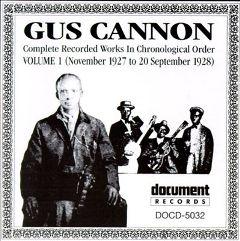Gus Cannon Vol.1 1927 – 1928 (1991)
Gus Cannon Vol.1 1927 – 1928 (1991)

Gus Cannon (Banjo Joe) 01 - Jonestown blues 02 - Poor boy, long ways from home 03 - Madison Street rag 04 - Jazz gypsy blues 05 - Can you blame the colored man 06 - My money never runs out Cannon's Jug Stompers 07 - Minglewood blues 08 - Big railroad blues 09 - Madison Street rag 10 - Springdale blues 11 - Ripley blues 12 - Pig ankle strut 13 - Noah`s blues 14 - Hollywood rag 15 - Heart-breakin` blues 16 - Feather bed 17 - Cairo rag 18 - Bugle call rag 19 - Viola Lee blues (take 1) 20 - Viola Lee blues (take 2) 21 - Riley`s wagon Gus Cannon (Banjo Joe), vocal, banjo, speech, whistling, kazoo. Cannon’s Jug Stompers. Including: Gus Cannon, vocal, banjo, jug, Ashley Thompson, vocal, guitar; Noah Lewis, harmonica; Elijah Avery, banjo, guitar, kazoo, Hosea Woods, kazoo. Blind Blake, guitar.
Gus Cannon was already in his mid-forties when he came to record in 1927, so it's not surprising that at his first sessions he cut Poor Boy, Long Ways From Home, one of the earliest blues, setting it to a unique slide banjo accompaniment. His sessions as "Banjo Toe" also featured ragtime pieces and medicine show songs, among them the once-typical Can You Blame The Colored Man, a funny,albeitsomewhat Uncle Tommish, song about Booker T. Washington's 1901 visit to the White House. Blind Blake, who helped out with second guitar on most titles, was added at Paramount’s behest; they had never met before the session.
Some of "Banjo Joe's" songs were remade by Cannon's Jug Stompers in the course of their studio career; Madison Street Rag was one of them, recorded at the band's first session for Victor, early in 1928. The Stompers played a lot of ragtime and novelty pieces, but even on these they were the most consistently bluesy of the Memphis jug bands on record. This was largely thanks to the magnificent harmonica of Noah Lewis, whose immensely forceful playing was always subordinate to an acute musical intelligence, resulting in some of the most sensitive and responsive harmonica work in blues. He injects a haunting, lonesome sound into his playing, a quality which also made his voice perfect for blues, as he proves on the two takes of Viola Lee Blues. Gus himself played both the rushing, syncopated banjo figures that made the band's blues numbers dance, and the fruity, ribald jug (in his case actually a coal-oil can) which he'd mounted on a neck harness.
Lewis, was from Henning, Tennessee, not far from Ripley, to which he paid tribute on Ripley Blues. The Jug Stompers seem to have been keen to boost Memphis and other places they knew: besides Madison Street Rag, Hollywood Rag refers to a suburb of Memphis containing the Springdale Avenue of Springdale Blues; Jonestown was a hamlet in Mississippi; and Mengelwood, wrongly spelt on the record, was a sawmill camp near Ripley. Cairo Rag is named after the Illinois town. Of the same generation as Noah was his neighbour, the guitarist Ashley Thompson, who is also an excellent singer on two titles. Nevertheless, he was dropped after one session and replaced by Elijah Avery who played both banjo and guitar, but left the singing to Lewis and Gus himself, whose booming voice can be heard on Riley's Wagon and Feather Bed, among others. As 1928 gave way to 1929, Gus Cannon must have been well satisfied with his band's success on Victor. The next two years were to see more classic songs recorded, including one that was to bring him an unlikely moment or fame 34 years later; Elijah Avery's replacement by Hosea Woods; and Noah Lewis cutting sides under his own name. All these developments are chronicled on Document CD DOCD-5033, which completes the story of the finest jug band to come out of Memphis. ---document-records.com
download (mp3 @192 kbs):
yandex mediafire ulozto gett solidfiles
Last Updated (Tuesday, 02 February 2021 21:21)








